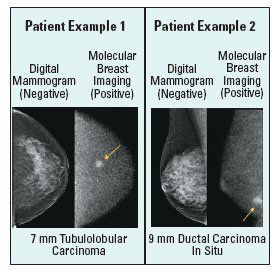Molecular breast imaging detects mammographically occult cancers
WASHINGTON-Molecular breast imaging appears to be a promising adjunctive modality for breast cancer screening among women with an elevated risk of breast cancer who have dense breast tissue, according to a report at the ASCO 2008 Breast Cancer Symposium (abstract 68).
ABSTRACT: New modality has superior sensitivity and equal specificity in high-risk women with dense breast tissue.

WASHINGTON-Molecular breast imaging appears to be a promising adjunctive modality for breast cancer screening among women with an elevated risk of breast cancer who have dense breast tissue, according to a report at the ASCO 2008 Breast Cancer Symposium (abstract 68).
Although mammography is the standard of care for breast cancer screening, it has poor performance in certain women, such as those with dense breast tissue, said Carrie B. Hruska, PhD, a research fellow in the section of nuclear medicine at the Mayo Clinic, Rochester, Minnesota.
MBI uses a radiotracer (Tc-99m sestamibi) and two opposing gamma cameras to functionally image the breast.
“MBI has several advantages, including its relatively low cost, the ease with which it can be implemented, its production of images that are easy to interpret, and, above all, its ability to detect cancers in mammographically dense breasts,” Dr. Hruska explained.
For their study, Dr. Hruska and her colleagues enrolled women who were asymptomatic on screening mammography but had more than 50% mammographically dense breast tissue. They also had at least one additional risk factor for breast cancer, such as a personal or family history of the disease, or a genetic mutation.
The women underwent both screening mammography and MBI; the radiologists reading the MBIs were blinded to the mammographic results and other information. Breast cancer diagnoses were established from pathologic findings during a 15-month follow-up.

A total of 940 patients were enrolled in the ongoing study. As of an interim analysis, 13 cancers have been detected in 12 women, Dr. Hruska reported. Mammography detected 3 of the cancers, MBI detected 10, and the two modalities combined detected 11.
Among the 375 patients with complete 15-month follow-up, MBI had significantly greater sensitivity than mammography (75% vs 25%) and comparable specificity (93% vs 91%). The recall rate was somewhat lower with MBI than with mammography (7.7% vs 9.4%). And although MBI triggered a greater number of biopsies (36 vs 17), it had a higher positive predictive value (28% vs 18%).
“Based on these results, MBI has shown great promise as a valuable adjunct to screening mammography for women who have dense breasts on mammograms and are at increased risk of developing cancer,” Dr. Hruska concluded.
Money matters
The estimated cost of MBI would be about $500, making it somewhat more expensive than mammography and ultrasound, but markedly less expensive than breast MRI. “We just started a head-to-head comparison of MBI vs breast MRI, because we want to further identify its role as possibly a low-cost alternative for those who either don’t have access to an MRI or can’t afford it,” she said.
Women in the study received 20 mCi of the radiotracer-or about one-third of the dose typically delivered during a myocardial perfusion study using the same tracer, according to Dr. Hruska. However, she acknowledged that this dose would still be a limiting factor to performing MBI annually or every other year. “We believe that we can reduce the dose by a factor of at least 5 times but possibly 10 times, so that it would be at a level that would be comparable to a screening mammogram,” she said.
Commentary
Commenting on the study, Eric Winer, MD, of Harvard Medical School, called it “important work because at present, while breast cancer screening with mammography and clinical breast exams has been somewhat successful, we all know that mammography is, in and of itself, an imperfect tool.”
He noted that although MRI has recently received much attention, its role in this screening setting is still up for debate (see “Is breast MRI primed for widespread use as a high-risk screening tool?,” August 2008, page 19).
Dr. Winer predicted that the near-future will bring individualized strategies for breast cancer screening. “We talk about personalized medicine when it comes to breast cancer treatment, but more and more we may be getting away from one-size-fits-all screening approaches and instead thinking about screening approaches that are directed more to an individual woman based on both her risk and the characteristics of her breasts,” he said.